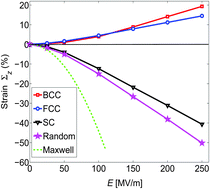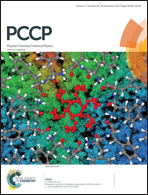A simulation study of the electrostriction effects in dielectric elastomer composites containing polarizable inclusions with different spatial distributions
Abstract
Controlled actuation of electroactive polymers with embedded high dielectric nanoparticles is theoretically analyzed. If the inclusions are placed randomly in the elastomer body, the composite always contracts along the direction of the applied field. For a simple cubic distribution of inclusions, contraction occurs if the applied field is directed along the [001] direction of the lattice. For inclusions occupying the sites of other lattice structures such as body-centered or face-centered cubic crystals, the composite elongates along the field direction if it is applied along the [001] direction. The stability of the elongation against the imperfectness of the lattice site positions and the distortion ratio of the initial structures are examined. Finite elongation windows show up for the initially distorted body-centered cubic and face-centered cubic crystals as a function of the distortion ratio of the initial structure. The existence of these elongation windows are also predicted from the analysis of the electrostatic energy of the distorted body-centered cubic and face-centered cubic lattice structures. Our results indicate that the electrostriction effect, which is the main contribution to the actuation of low aspect-ratio composites, strongly depends on the geometry of the spatial distribution of nanoparticles, and can thereby largely be tuned.


 Please wait while we load your content...
Please wait while we load your content...